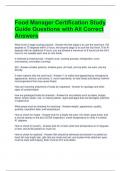Food Manager Certification Study
Guide Questions with All Correct
Answers
What is the 2 stage cooling process - Answer-the first stage is to cool the food from 135
degrees to 70 degrees within 2 hours. the second stage is to cool the food from 70 to 41
degrees with an additional 4 hours. you are allowed a maximum of 6 hours but the full 6
hours is not needed each time to cool foods.
4 methods to thawing food - Answer-crow. cooking process, refrigeration, oven
(microwave), and water (running).
3SI - Answer-smaller portions, shallow pans, stir food, and ice bath, ice want, and ice
directly.
2 main reasons why we cook food - Answer-1. to make food appetizing by changing its
appearance, texture, and aroma. 2. more importantly, to heat foods and destroy harmful
microorganisms that may cause illness
How are incoming shipments of foods be inspected - Answer-for spoilage and other
signs of contamination
how are packaged foods be checked - Answer-for any defects such as leaks, bulges,
dents, broken seals, rust, or missing labels. reject packages that are damaged, patched,
or taped shut
What areas must be checked for receiving - Answer-weight, appearance, quality,
quantity, expiration date, and temperature.
How to check for meats - Answer-look for a bright red color, firm flesh, good smell, and
a circular stamp on the box (USDA inspection). check temperature to verify it is below
41 degrees.
How to check for poultry - Answer-look for a fresh smell and temperature at 41 degrees
or less. should be placed on crush ice.
How to check for seafood - Answer-fish should be delivered and stored in crushed ice.
fresh fish has bright skin, gills that are moist and red, and scales firmly attached. eyes
must be clear and bulging. flesh must be firm and elastic.
, Symptoms of Food borne illness - Answer-cramping in the abdominal area, vomiting,
nausea, diarrhea, fever, and dehydration.
2 foodborne illness - Answer-1. infection
2. contamination
foodborne infection - Answer-produced by the ingestion of living, harmful organisms
present in food. Such as bacteria, viruses, or parasites. Infection have a delayed onset
2 bacteria most associated with foodborne infection - Answer-salmonella and E. coli
foodborne intoxication - Answer-an illness produced by ingestion of bacterial toxins or
excrement that are present in food before it is consumed. Intoxication have a rapid
onset
2 bacteria associated with foodborne intoxication - Answer-staphylococcus aureus and
clostridium botulinum.
3 main areas of food safety and sanitation - Answer-1. time and temperature
2. heat and cold
3. the washing of hands and ware-washing (i.e., dishware, glassware, pots and pans
4 high risk population - Answer-1. pregnant/ nursing(lactating) women
2. infants and children
3. elderly
4. impaired immune systems
Sources of Contamination - Answer-foodborne outbreak
foodborne outbreak - Answer-an incident or event where two or more people suffer a
similar illness or sickness from eating a common food
food becomes contaminated for the following reasons - Answer-food handlers, food
contact surfaces, packaging materials, soil, water, air, ingredients, and pests
food contact surfaces should be cleaned regularly. At least how many hours? - Answer-
every 4 hours
Non food contact surfaces should always be kept free of..... - Answer-dirt, dust,and
other particles.
all packaging material (such as bags of flour) should be how many inches from the
ground? - Answer-At least 6 inches
Food contaminants can be grouped into what 4 catergories - Answer-1. biological 2.
physical 3. chemical 4. cross contamination




